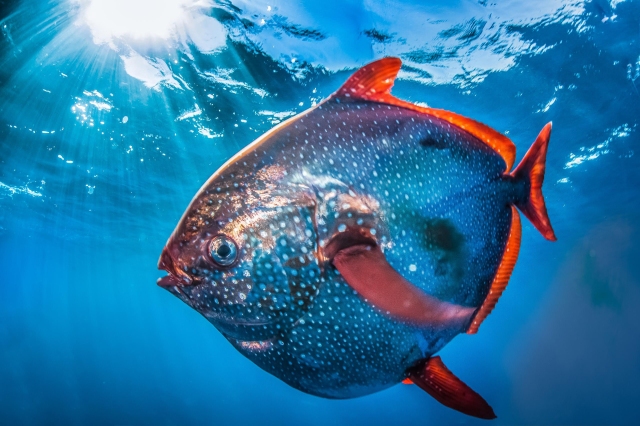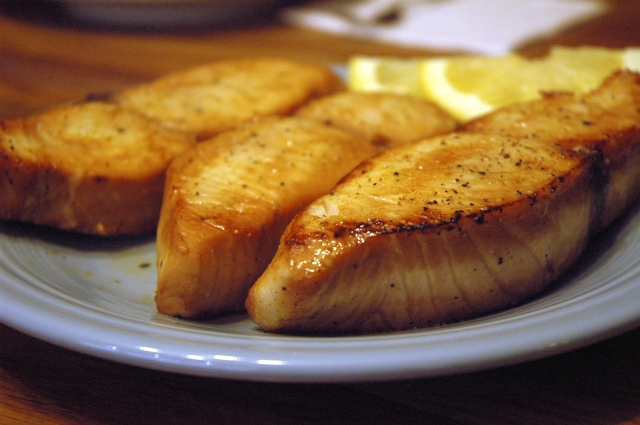OPAHS, also commonly known as moonfish, sunfish, kingfish red-fin ocean pan and Jerusalem haddock, are large, colourful, deep-bodied PELAGIC LAMPRIFORM fishes, from the family LAMPRIDIDAE, from the Greek “LAMPRID” meaning “brilliant” or “clear.”
OPAHS are frequently caught as “by-catch” in many long-line tuna fisheries. OPAH is becoming increasingly popular in seafood markets. It first became popular as a “sushi” and “sashimi” in the late 1980s and early 1990s. The meat is lightly flavoured and lends itself well to a variety of preparations, principally SAUTE. OPAH flesh has a light-ping to orange colour, but turns white when cooked. It is popular in Hawaii, especially in restaurants. An average of 35% of an OPAH’S weight is consumable, with the remaining 65% being bones and thick skin.
OPAHS are deeply-keeled, compressed, discoid fish with conspicuous colouration (deep red-orange grading to rosy on the belly), with white spots covering the flanks. Both the “median” and “paired” fins are a bright “vermilion”. The large eyes stand out, as well, ringed with golden yellow. The body is covered in minute “cycloid scales” and its silvery, iridescent guanine coating is easily abraded. OPAHS have enlarged pelvic fins with about 14-17 rays, which distinguish them from superficially similar CARANGIDS. The snout is pointed and the mouth small and toothless.
They are the first fish discovered to be “completely warm-blooded”. Most fish have body temperatures that match the surrounding water. A small number of them can warm specific parts of their bodies. Swordfish, marlins and sailfish can, temporarily heat their eyes and brains, sharpening their vision when pursuing prey. Tuna and some sharks, including the mako and the great white, can do the same with their swimming muscles, going into “turbo mode” when they need to. But, none of these can heat their “entire bodies”. Their hearts and vital organs stay at “ambient temperature”, so, while they can hunt in deep, cold waters, they must regularly return, to the surface, to warm their innards. The OPAH as no such problem. It can “consistently” keep its entire body around 5 degrees Celsius warmer than its environment. When an OPAH was dissected, it was discovered that the gills contained a “beautiful and intricate tangle of red and blue blood vessels called RETIA MIRABILIA, Latin for “wonderful nets” —- and they are the secret behind the “heating system” of the OPAH.
The OPAH’S “wonderful nets” are in its gills, and that makes all the difference. The blood vessels carrying “warm” blood from heart to gills flows next to those carrying “cold” blood from the gills to the rest of the body, warming them up. So, while a tuna or shark might isolate its “warm muscles” from the rest of its “cold body”, the OPAH “flips this arrangement”. It “isolates” the “cold bits” (the gills) from everything else. The OPAH’S brain is warm. Its muscles are warm. And, perhaps, most importantly, its heart is warm —— A FIRST FOR A FISH.. That is why OPAH can stay deep down, because they are “specialised” for living deeper than other predators.
There’s nothing about OPAH that says “fast-moving predator”. Tuna, sharks and swordfish are “fast-moving predators” and accordingly, their bodies look like “streamlined torpedoes”. By contrast, the OPAH looks like a “big, startled Frisbee”, with thin red fins stuck on “as an afterthought”. It is pretty (silver body and red fins) and big(up to 2 metres long), but is it fast ? It was discovered that the OPAH is an “active predator” and it has a trait that no other fish possesses ——- IT IS WARM-BLOODED. They are able to maintain their eyes and brain at 2 degrees Celsius warmer than their bodies, a phenomenon called “cranial endothermy”. This may allow their eyes and brains to continue functioning during deep dives (50-400m) under water. ———–Squids and krill make up the bulk of the OPAH diet. Their primary predators, aside from humans are large pelagic sharks. They are believed to have a low population resilience.
The OPAH is a “comically beautiful fish” ———— AS BIG AS A CAR TIRE & SHAPED LIKE ONE.




Reblogged this on oshriradhekrishnabole.